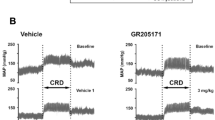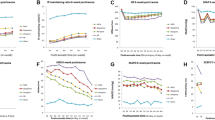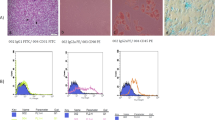Abstract
DA-8159 is a pyrazolopyrimidinone derivative which exhibits potent and selective phosphodiesterase type 5 (PDE5) inhibition. The aim of this study was to investigate the effects of DA-8159 on inducing a penile erection in rabbits with an acute spinal cord injury (ASCI). DA-8159 was given either orally (1, 3, or 10 mg/kg) or intravenously (0.1 or 0.3 mg/kg) to conscious male albino rabbits with a surgical transection of the spinal cord at the L2–L4 lumbar vertebra or ischemic-reperfusion SCI rabbits. Erection was evaluated in a time-course manner by measuring the length of the uncovered penile mucosa. DA-8159 induced a dose-dependent erection in both transection and ischemic-reperfusion ASCI rabbits. The efficacy of DA-8159 was potentiated by an intravenous injection of sodium nitroprusside, a nitric oxide donor. Potentiation of the effect by nitric oxide donor implies that DA-8159 can enhance the erectile activity during sexual arousal. These results suggest that DA-8159 may be useful for treating erectile dysfunction in patients with an SCI.
This is a preview of subscription content, access via your institution
Access options
Subscribe to this journal
Receive 8 print issues and online access
$259.00 per year
only $32.38 per issue
Buy this article
- Purchase on Springer Link
- Instant access to full article PDF
Prices may be subject to local taxes which are calculated during checkout





Similar content being viewed by others
References
Andersson KE, Wagner G . Physiology of penile erection. Physiol Rev 1995; 75: 191–236.
Burnett AL et al. Nitric oxicde: a physiologic mediator of penile erection. Science 1992; 257: 401–405.
Ignarro LJ et al. Nitric oxide and cyclic GMP formation upon electrical stimulation cause relaxation of corpus cavernosum smooth muscle. Biochem Biophys Res Commun 1990; 170: 843–850.
Kim N, Azadzoi KM, Goldstein I, Saenz de Tejada I . A nitric oxide-like factor mediates nonadrenergic–noncholinergic neurogenic relaxation of penile corpus cavernosum smooth muscle. J Clin Invest 1991; 88: 112–118.
Azadzoi KM et al. Endothelium-derived nitric oxide and cyclooxygenase products modulate corpus cavernosum smooth muscle tone. J Urol 1992; 147: 220–225.
Trigo-Rocha F et al. The role of cyclic adenosine monophosphate, cyclic guanosine monophosphate, endothelium and nonadrenergic noncholinergic neurotransmission in canine penile erection. J Urol 1993; 149: 872–877.
Lugg JA, Gonzales-Cadaved NF, Rajfer J . The role of nitric oxide in erectile function. J Androl 1995; 16: 2–4.
Burnett AL . Nitric oxide in the penis; physiology and pathology. J Urol 1997; 157: 320–324.
Beavo JL . Cyclic nucleotide phosphodiesterases: functional implications of multiple isoforms. Physiol Rev 1995; 75: 725–748.
Ballard SA et al. Effects of sildenafil on the relaxation of human corpus cavernosum tissue in vitro and on the activities of cyclic nucleotide phosphodiesterase isozymes. J Urol 1998; 59: 2164–2171.
Junemann KP, Buhrle CP, Persson-Junemann C . Pathophysio-logy of neurogenic impotence. Sex Disabil 1994; 12: 5–15.
Aloni R et al. Non-invasive treatment for erectile dysfunction in the neurologically disabled population. J Sex Marital Ther 1992; 18: 243–249.
Bodner DR, Haas CA, Krueger B, Seftel AD . Intraurethral alprostadil for treatment of erectile dysfunction in patients with spinal cord injury. Urology 1999; 53: 199–202.
Lloyd LK, Richards JS . Intracavernous pharmacotherapy for management of erectile dysfunction in spinal cord injury. Paraplesia 1989; 27: 457–464.
Sanchez RA et al. Efficacy, safety and predictive factors of therapeutic success with sildenafil for erectile dysfunction in patients with different spinal cord injuries. Spinal Cord 2001; 39: 637–643.
Gans WH et al. Efficacy and safety of oral sildenafil in men with erectile dysfunction and spinal cord injury. J Spinal Cord Med 2001; 24: 35–40.
Schmid DM, Schurch B, Hauri D . Sildenafil in the treatment of sexual dysfunction in spinal cord-injured male patients. Eur Urol 2000; 38: 184–193.
Maytom MC et al. A two-part pilot study of sildenafil (VIAGRA) in men with erectile dysfunction caused by spinal cord injury. Spinal Cord 1999; 37: 110–116.
Oh TY et al. Erectogenic effect of the selective phosphodiesterase type 5 inhibitor, DA-8159. Arch Pharm Res 2000; 23: 471–476.
Doh H et al. Mechanism of erectogenic effect of the selective phosphodiesterase type 5 inhibitor, DA-8159. Arch Pharm Res 2002; 25: 873–878.
Tetik O et al. An intraaortic solution trial to prevent spinal cord injury in a rabbit model. Eur J Vasc Endovasc Surg 2001; 22: 175–179.
Cassada DC et al. Systemic adenosine A2A agonist ameliorates ischemic reperfusion injury in the rabbit spinal cord. Ann Thorac Surg 2001; 72: 1245–1250.
Parrino PE et al. Spinal cord protection during aortic cross-clamping using retrograde venous perfusion. Ann Thorac Surg 1999; 67: 1589–1595.
Agee JM et al. Reducing postischemic paraplesia using conjugated superoxide dismutase. Ann Thorac Surg 1991; 51: 911–915.
Herold JA et al. Complete prevention of postischemic spinal cord injury by means of regional infusion with hypothermic saline and adenosine. J Thorac Cardiovasc Surg 1994; 107: 536–542.
Okita Y et al. Repair of aneurysm of the entire descending thoracic aorta or thoracoabdominal aorta using a deep hypothermia. Eur J Cardio-thorac Surg 1997; 12: 120–126.
Simpson JI et al. Intrathecal magnesium sulfate protects the spinal cord from ischemic injury thoracic aortic cross-clamping. Anesthesiology 1994; 81: 1493–1499.
Comarr AE . Sexuality and fertility among spinal cord and/or cauda equine injuries. J Am Paraplesia Soc 1985; 8: 67–75.
Sonda LP, Mazo R, Chancellor MB . The role of yohimbine for the treatment of erectile impotence. J Sex Marital Therap 1990; 16: 15–21.
Rivas DA et al. Erectile response to topical, intrurethral and intracorporal pharmacotherapy in a rat model of spinal cord injury. J Spinal Cord Med 1995; 18: 145–150.
Aydin S et al. Effects of sildenafil citrate, acethylcholine, and sodium nitroprusside on the relaxation of rabbit cavernosal tissue in vitro. Urology 2001; 58: 119–124.
Brown JH, Taylor P . Muscarinic receptor agonists and antagonist. In: Hardman JC et al (eds). Goodman and Gilman's The Pharmacological Basis of Therapeutics, 9th edn. McGraw-Hill professional, New York, 1995, pp 141–160.
Giuliano F et al. Sildenafil citrate (VIAGRA): a novel oral treatment for erectile dysfunction caused by traumatic spinal cord injury. Int J Clin Pract Suppl 1999; 102: 24–26.
Hall ED, Wolf DL . Pharmacological analysis of the pathophysiological mechanism of post-traumatic spinal cord ischemia. J Neurosurg 1986; 64: 951–961.
Hall ED, Wolf DL . Neuroprotective pharmacology of methylprednisolone. J Neurosurg 1992; 76: 13–22.
Rahman A et al. Neuroprotective effect of regional carnitine on spinal cord ischemia–reperfusion injury. Eur J Cardiothorac Surg 2001; 20: 65–70.
Tai C, Booth AM, de Groat WC, Roppolo JR . Penile erection produced by microstimulation of the sacral spinal cord of the cat. IEEE Trans Rehabil Eng 1998; 6: 374–381.
Mautes AEM, Weinzierl MR, Donovan F, Noble LJ . Vascular events after spinal cord injury: contribution to secondary pathogenesis. Phys Ther 2000; 80: 673–687.
Author information
Authors and Affiliations
Corresponding author
Rights and permissions
About this article
Cite this article
Ahn, B., Kang, K., Ahn, G. et al. Efficacy of DA-8159, a new PDE5 inhibitor, for inducing penile erection in rabbits with acute spinal cord injury. Int J Impot Res 15, 405–411 (2003). https://doi.org/10.1038/sj.ijir.3901055
Received:
Revised:
Accepted:
Published:
Issue Date:
DOI: https://doi.org/10.1038/sj.ijir.3901055
Keywords
This article is cited by
-
Transport of a new erectogenic udenafil in caco-2 cells
Archives of Pharmacal Research (2007)



